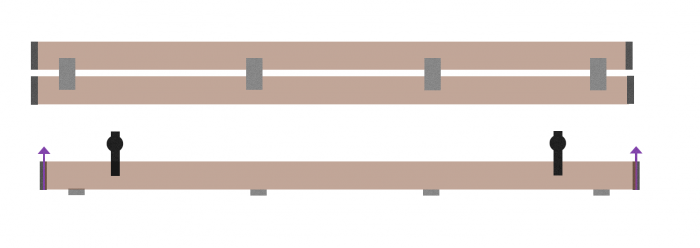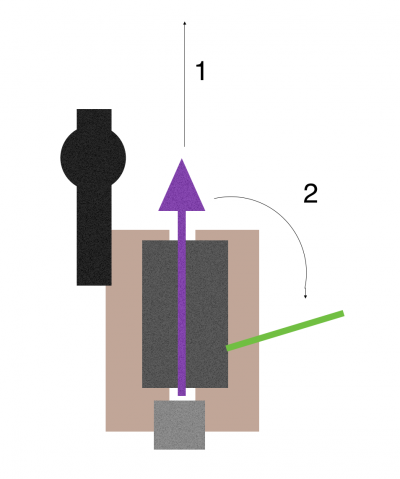Kabuki Drop
Eugene Onegin 2008
Effects – Kabuki drop from Eugene Onegin 08 by Callum Howie
The main stage effect in Eugene Onegin 08 is a kabuki drop, I will explain the effect and how we achieved it in the show, and I will also describe how to make one on the cheap.
Kabuki is the traditional style of Japanese theatre and the kabuki drop is the most common effect export from the style. The effect is when a flown cloth drops to the floor. As the cloth falls the air pressure on either side of the cloth causes it to fall straight down with small ripples in it. The effect is used to reveal the scene behind.
See this video www.youtube.com/watch?v=aIzHGg3lhOs
There are many different types of mechanisms to make the drop both mechanical and electronic which are available to buy or hire.
The kabuki drop used on Eugene Onegin 08 was an electromagnetic drop which is owned by Scottish Opera. The way this system works is a barrel with pins is attached to a standard flying bar. This barrel is loose and is able to spin; the barrel has two “arms” which are set inline with the pins. The arms have half of the electromagnet on it; it reaches to a platform which is fixed to the same flying bar. When in preset the arms are located to the platforms and the pins are pointing up. The ties are then able to sit securely. Again in the preset the magnets are attracted to each other with no current passing through the system, this is so that if there is a power failure the cloth will not drop.
When the system is fired the current pushes the magnets apart and the weight of the arms spins the barrel and makes the pins point downwards and the ties simply slip off.
The version of the drop we used in Eugene Onegin was altered slightly from a standard drop. Firstly the cloth was, by design, only half depth so the cloth had cord extensions to the ties from the cloth up to the bar. The cloth also had ties rather than eyes as well which it should have been for the way the Scottish Opera Kabuki drop works.
To make your own Kabuki Drop on the cheap is very simple.
- Get a wooden baton across the length of the drop.
- Lay out your cloth and mark on the baton where your ties are.
- place two screw eyes where each of your ties sit
- place a stage pin in between the two eyes
- Run a control line across the length of the baton also tie off to the end of the baton so the pins do not whip across the stage.
- From each pin tie up to the control line so that when you pull the control line all pins fall from the eyes.
- Tie your cloth to the pins.
The Seagull 2009
This project was undertaken by Kirsty Campbell for The Seagull which performed in the New Athenaeum Theatre November 2009
A kabuki drop is an effect used to achieve the sudden falling of an item such as a curtain, banner or fake body. Although there are various electric versions available at a price, it is also possible to make a simple manual Kabuki drop with the sort of hardware lying around on stage. For the recent production of the seagull we were required to design a mechanism which would allow six 4x8 meter soft black masking legs to drop to the ground at the same time. Below is a diagram of the chosen design, here is the video of the result.

Construction
For the main timber part of the design we chose to use CLS as this is thicker and sturdier than normal 20x70 timber. It is also less prone to warping and would give the masking a more even appearance, as well as being easier to drill repeatedly. Standard 55mm screw eyes were used along with thick loop pins to ensure that the weight of the masking wouldn't bend the pins and make them impossible to pull out. After some trial and error it was found that the best way to attach the masking leg to the Kabuki bar was with cable ties pulled through the cloth next to the ties at the top of the leg. This means that there is a connection which is less likely to get caught than the ties on the masking. To attach the kabuki bars to the flying bar we used barrel clamps.
Things to look out for
- It is extremely important to number the masking legs or other items in relation to the kabuki bars when more than one is being used, especially if the dropped items are being moved away from the area after the cue has taken place. Doing this will make the reset process much faster.
- If you do not want the string and pins to drop after the item has fallen, it is a good idea to tie the onstage end to the onstage end of the kabuki bar.
- If at any point items such as masking legs have to be moved whilst set in position make sure that they are pulled in a direction which will not cause them to drop e.g. if the string is being pulled from stage right, twist the leg towards stage left.
Inner Space 2016
Inner Space 2016 was a variety show done by PTM 1 in the New Athenaeum Theatre. The drop was designed by Yesha Subotincic West. It was built and rigged and operated by Amy Dawson, Dimitri Grant, Heather McKennan, Yesha Subotincic West and Reece Flynn.
Design and Construction
The design of the show and the lack of any budget requited us to make a drop ourselves. It was also a great opportunity. The show was set with the stage facing R1 so lengthwise and took up neatly all the available space with a square of hanging truss 6m up. For that reason we could not use a classic pin and screw eye kabuki because it must be pulled from an angle we could not get to. The design consisted of 2 wooden boards connected with back flap hinges. The front board had 17 angles nails pointing out toward the audience for the cloth to hang on the ends of the boards they were kept folded up by 2 pin hinges. The drop was released by pulling the pin out with a line run up to the grid and over to fly floor. Not shown in the diagrams below are 2 lines that run between the front and back board with stopper knots to stop the board form falling past 90 degrees so that the cloth is not thrown around and fall in an uncontrollable place. The cloth was a white gauze doubles over because of the size of the stage in relation to the size of the gauze. The ties were tied around loose cable ties to increase the slideyness of the cloth. It fell on to a leg laid out on the floor and was stuck by wrapping it up in the black and carrying it with 3 people from the front of the stage to the void.
Click here to see a video of the test drop and the full size drop.
Cabaret 2016
Depending on how you count it there were 5 kabuki drops in Cabaret. The first one was the curtain silk drop at the reveal of the Kit Kat Klub which was an electro kabuki borrowed from Scottish Opera. This article is about the other drops. The second one was 2 nazi banners that unrolled over the audience at the end of Act 1 during Tomorrow Belongs To Me.
Design
The final design consisted of 2 boards, 1 for each banner.
Rigging
Operation
Click here to see the 2 banner drops


